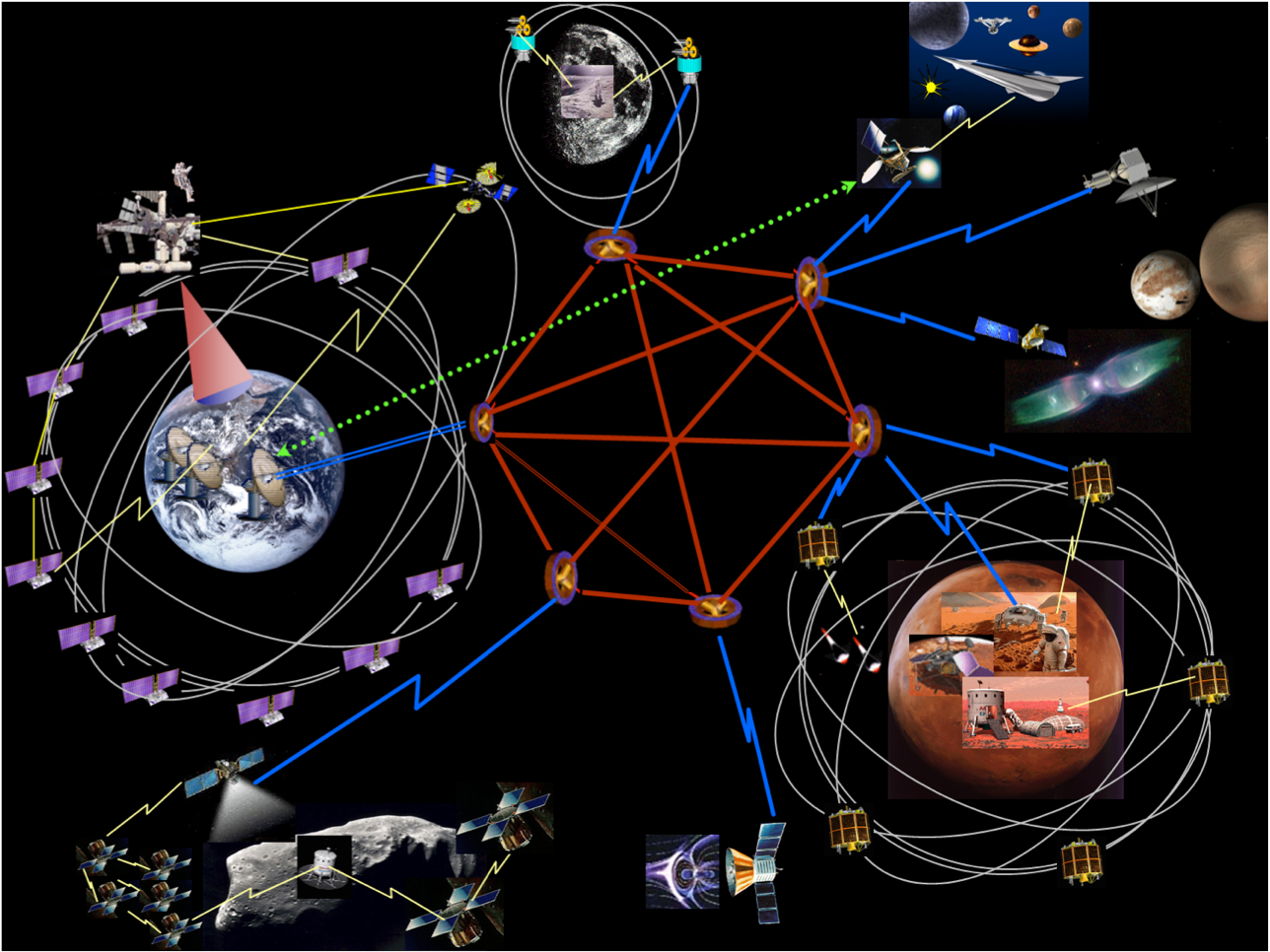Becky Ferreira reports in Motherboard:
If humans want to expand civilization deeper into the solar system we need an orbital internet to support the data needs of a spacefaring population. Even if space remains largely the domain of robots, networked devices have the capacity to collect and distribute information relative to the radio links used today. Since the 1990s, NASA has been developing a Delay/Disruption-Tolerant Network (DTN) that could link spacecraft, rovers, and landers all over the solar system to Earth. “DTN protocols do for the solar system what internet protocols did for the Earth.. Internet protocols allowed us to take existing phone lines to network systems together.”
At a recent summit about space commerce, Deborah Barnhart, director of the U.S. Space and Rocket Center, was asked if she has any predictions about the first words spoken by humans on Mars. She deferred to the kids and teenagers who attend her center’s Space Camp program for her answer.
“Overwhelmingly, it's: 'What's the Wi-Fi password?'" Barnhart said, according to Jeff Foust of SpaceNews.
While that phrase is not quite so lofty as Neil Armstrong’s historic "One small step for [a] man, one giant leap for mankind," uttered on the Moon 50 years ago, it does reflect the practical reality that the internet will follow humans wherever we go—even if that means into deep space or to the surface of other planets.
Since the dawn of spaceflight, most spacecraft have communicated by sending radio signals to each other and to ground stations. The flow of information is typically slanted one-way, from the spacecraft to Earth, and the link is not normally shared beyond a few devices.
But if humans want to expand our civilization deeper into the solar system—an aim that is itself a topic of vigorous debate—we will need an orbital internet revolution to support the immense data needs of a spacefaring population. Even if space remains largely the domain of robots, networked devices have the capacity to collect and distribute vast amounts of information relative to the radio links used today.
Anyone who has experienced a spotty connection when their router is in the same room might be skeptical of this vision to build a functional internet in outer space. But since the 1990s, NASA researchers have been developing something called a Delay/Disruption-Tolerant Network (DTN) that could link spacecraft, rovers, and landers all over the solar system to Earth.
“The DTN protocols do for the solar system what internet protocols did for the Earth,” David Israel, a space communications architect at NASA's Goddard Space Flight Center, said in a phone call. “Internet protocols allowed us to take existing phone lines, in the beginning, and start to network systems together.”
The DTN will offer the same networking advantages to space devices, he explained.
The project to build the internet in space is related to, but distinct from, ongoing efforts to establish huge satellite internet constellations. SpaceX, OneWeb, Boeing, and many other commercial entities are currently racing to launch internet constellations, which will likely lead to the deployment of thousands of new spacecraft in low-Earth orbit over the next decade.Concept art of DTN system. Image: NASA
For the most part, satellite internet constellations will be focused on improving the speed, efficiency, and availability of broadband for people and devices on Earth—a.k.a. the terrestrial internet.
DTN, in contrast, would expand the internet of things into deep space and other planets, drastically changing the way humans interact with spacecraft.
The biggest challenge toward that goal is right there in DTN’s name: Delays and disruptions.
Internet traffic on Earth has proliferated due to near-instantaneous connections, but this luxury is not possible in outer space.
It takes minutes for light to travel between Earth and Mars, and hours for it to reach the outer solar system, so DTN must account for big temporal gaps. It must also be resilient to link disruptions caused by planetary bodies and other space phenomena cutting off communication between nodes in the network.
Some 20 years ago, researchers at NASA’s Jet Propulsion Laboratory (JPL) partnered with internet pioneer Vint Cerf to overcome these challenges. J. Leigh Torgerson, a space communications networking architect at JPL, has been on this team since its inception.
“We quickly realized that the standard internet protocols were unsuited to interplanetary use,” Torgerson said in an email. Internet protocols assumed “lots of ‘chatty’ interactions” with only milliseconds of bidirectional delay, he explained, and “no capability to store data along the way.”
To resolve the issue, the DTN team developed the “bundle protocol,” a system that automatically stores data at nodes until the next link in the network chain is firmly established.
Because the DTN is specifically designed for delays and disruptions, it is also useful in environments on Earth that frequently encounter link outages.
“DTN has already been used for distributed earthquake sensor nets, tracking and monitoring wildlife (with DTN-enabled tracking collars), lake water quality monitoring, and many interesting terrestrial applications,” Torgerson noted.





















1 comments:
Useful article, thank you for sharing the article!!!
Website: blogcothebanchuabiet.com chia sẻ những câu nói mỉa mai người khác hay stt một mình vẫn ổn và giải thích hiện tượng chim sẻ bay vào nhà là điềm gì.
Post a Comment